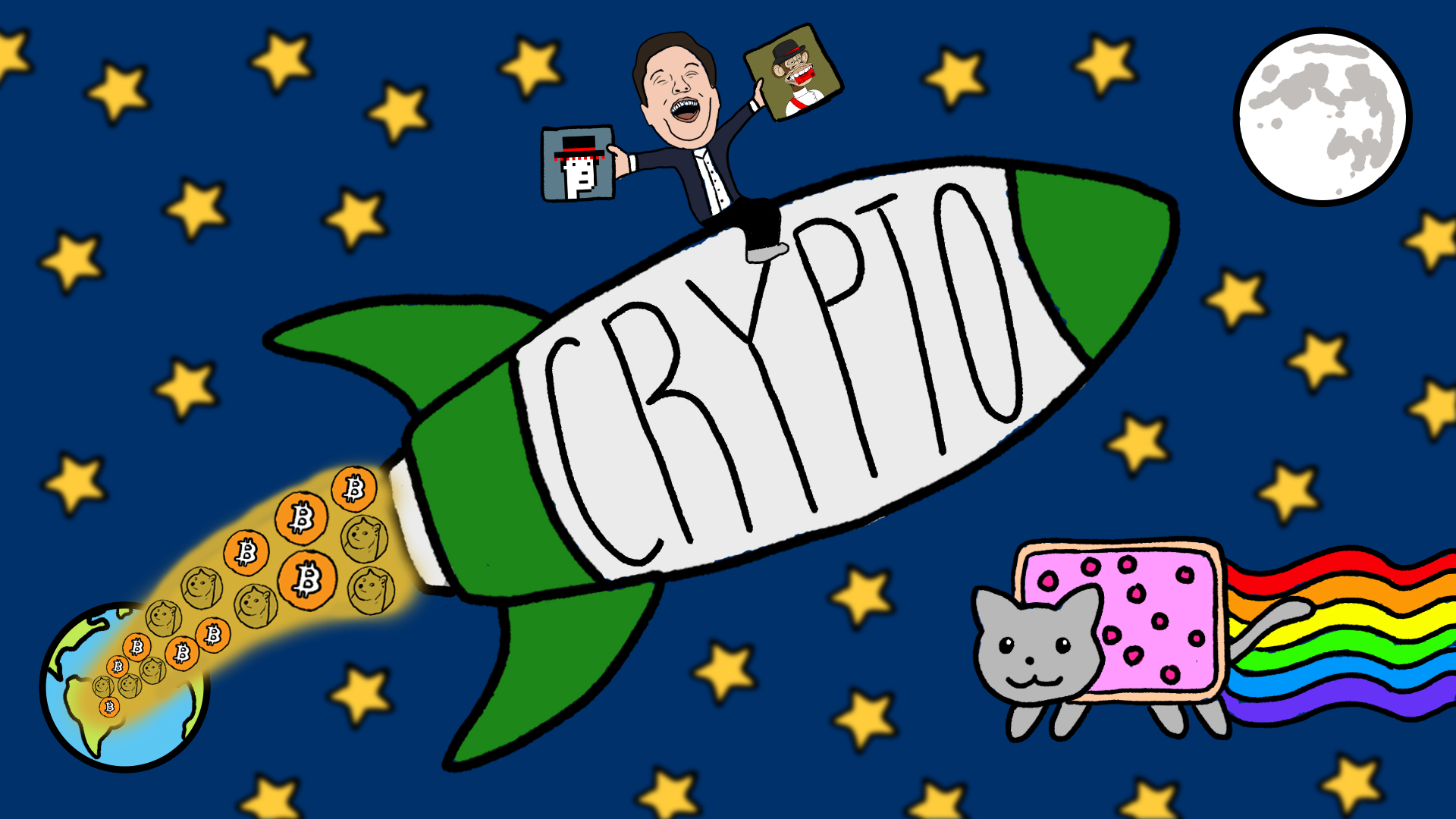
These days, the going price for a meme can be $580 thousand or more. The popular Nyan Cat GIF, an animation of a cat-Pop-Tart hybrid shooting through space on a rainbow trail, was sold for that price as an NFT, or non-fungible token. But it’s difficult to cuddle a digital cat, so what exactly did half a million dollars buy? According to the seller, “charisma, luck, and happiness.” But the true price was for ownership and personal use. While the price seems a tad ludicrous, Nyan Cat is a bargain compared to other NFTs on the market. With the highest reaching millions of dollars, NFTs are a flashy new trend.
NFTs and cryptocurrency are based on blockchain technology, which is an online, public and immutable record of transactions. NFTs are non-fungible, or unique, certificates of ownership for a one-of-a-kind product. On the other hand, cryptocurrencies are conversely fungible. Late last year, speculations regarding NFTs’ value were made, including possible real-world, exclusivity-based value. Recently, however, oversaturation of the market has led to a loss of value. Notably, an NFT of Jack Dorsey’s first ever tweet, bought for a price of $2.9 billion, only received offers as high as $277 when it was put back onto the market.
Cryptocurrency is a potential replacement for our current monetary system, promising cheaper and widely available access. Another major aspect of cryptocurrency is its decentralized nature, meaning it is not regulated by the government. Eager supporters believe that it holds a fundamental role in the future, possibly being as groundbreaking as the internet. On the other end of the spectrum, critics advocate for cryptocurrency’s complete ban. For most, whether cryptocurrency is a passing fad or a revolutionary innovation is still up for debate.
“I think crypto is an interesting idea, but it’s extremely overvalued right now,” said sophomore and Investor’s Club President Brennan Pavolotsky.
”I think crypto is an interesting idea, but it’s extremely overvalued right now”
Others have a similarly wary yet tentatively optimistic view.
“I consider their value to be kind of interesting,” said senior Alex Margolin. “On one hand, it is sort of unique to see where they might go in the future. I think it’s a little too early to tell exactly what’s gonna happen.”
For high school students, cryptocurrency is sometimes nothing more than a joke or a complicated mess of technical vocabulary.
“It’s stupid,” said freshman Carina Flores. “On social media, people buy things without knowing what they’re actually buying.”
While 16% of American adults have dabbled in cryptocurrency, only 9% of American teenagers have, according to Pew Research Center and Business Insider. Of course, there are constraints of age restrictions and net worth on cryptocrrency platforms.
“I do not think many high schoolers [invest in cryptocurrency],” Pavolotsky said. “It’s mainly people who understand the financial markets a lot.”
One might assume that the youngest generation would be the most interested in such a new invention, but the numbers disagree. A study by PCmag of about two thousand people revealed that Gen Z is skeptical of cryptocurrency. Less than half of Gen Z participants said they would buy any form of cryptocurrency.
Similarly, an overwhelming 82% of Gen Zs believed that NFTs are a scam. NFTs are closely associated with social media, with some celebrities selling ownership of their tweets, video clips and memes.
“As far as I can tell, [NFTs are] mostly influenced by stuff like internet trends and popularity,” Margolin said. “As an artist, I think that I would never, ever even consider [buying an NFT].”
Of course, there are a few teenagers like Victor Langlois, who have amassed a fortune in selling NFTs for their digital art. Called FEWOCiOUS online, Langlois made over $18 million dollars from NFTs of his art collection.
For most teenagers, however, NFTs are a challenging field to pursue.
“I tried starting my own NFT collection,” Pavolotsky said. “[But] it was not successful.”
Others affirm that NFTs are not as profitable for most people.
“[NFTs are a] very easy way to earn money if you have a large following,” Margolin said. “But I think the idea that the average person or even any artist can really make money off of them is just downright silly.”
As president of Investor’s Club, Pavolotsky has insight into other realms of digital currency.
“[Crypto trading] requires a lot of the ability to analyze a lot of technical indicators,” Pavolotsky said. “It can sometimes be, at least at the beginning, hard to pick up.”
“[Crypto trading] requires a lot of the ability to analyze a lot of technical indicators”
But even with such doubt, educating teenagers on cryptocurrency has become a goal for numerous startups. Even some high schools have reportedly started incorporating cryptocurrency into their curriculums.
“I think that classes [could talk] a little bit about the history of it,” Margolin said. “Or as part of an economics class, [it] could be fairly interesting.”
From the volatile Dogecoin to the increasingly mainstream Bitcoin, cryptocurrency is becoming one of the most relevant technologies in daily life. Along the way, it is also developing its own culture: a lucrative world of disruptive possibilities.




